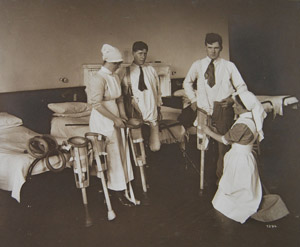New Hunterian exhibition tells Erskine story
Published: 22 September 2016
A new exhibition at the University of Glasgow’s Hunterian Museum celebrates the centenary of Erskine Hospital, 100 years after its foundation in 1916.
Erskine 100
In War and Peace: The Erskine Story
23 September 2016 – 8 January 2017
Hunterian Museum
Admission free
A new exhibition at the University of Glasgow’s Hunterian Museum celebrates the centenary of Erskine Hospital, 100 years after its foundation in 1916.
 In War and Peace: The Erskine Story tells of Scotland’s response to caring for limbless First World War veterans and presents images from the University of Glasgow Erskine Archive alongside film footage and related objects. Curated by Conflict Historian Professor Tony Pollard, the exhibition shows how the charity, now known as Erskine, was founded in 1916 to care for limbless sailors and soldiers returning from battle. Professor Pollard said:
In War and Peace: The Erskine Story tells of Scotland’s response to caring for limbless First World War veterans and presents images from the University of Glasgow Erskine Archive alongside film footage and related objects. Curated by Conflict Historian Professor Tony Pollard, the exhibition shows how the charity, now known as Erskine, was founded in 1916 to care for limbless sailors and soldiers returning from battle. Professor Pollard said:
‘The inspiration for this exhibition was Sir William Macewen, Regius Professor of Surgery at the University of Glasgow. It was while researching the University of Glasgow’s Great War people that we discovered he was the driving force behind the foundation of Erskine. His rousing speech at Glasgow City Chambers in 1916 contained a phrase that showed amazing foresight. He said: ‘... a generation will pass before all the work connected with the maimed and limbless from this War is at an end.’ Today, Erskine is still caring for veterans of all Britain’s subsequent conflicts and this resonates with my own research on the lasting results of war on landscapes and on people.’
Sir William Macewen was instrumental in the foundation of the first Erskine Hospital and the development of prosthetics. In his speech he envisaged a place where limbless men could be treated with ‘sympathetic care and encouragement’ whilst obtaining the best medical treatment. Rehabilitation, workplace retraining and a lifetime of support would be provided.
Erskine Hospital, then known as the Princess Louise Scottish Hospital for Limbless Sailors and Soldiers, was opened in October 1916. Located in Erskine House it included wards, recreation areas and an operating theatre, with workshops for the manufacture of limbs added in 1917 (previous to this they were made in the shipyards on the Clyde).
The exhibition highlights the horrors of war and the experience of the hospital’s first patient - Corporal James Ritson of the 1/5th Royal Scots Fusiliers who had his left hand amputated due to injuries sustained at Gallipoli.
Other highlights include:
- An early example of an artificial right leg, made for Erskine House between 1916 and 1918, on loan from the Science Museum, London. This is the only known surviving example of an Erskine leg.
- A replica admissions register from the Princess Louise Scottish Hospital for Limbless Sailors and Soldiers covering the period 1916-1936 containing 12,638 admissions. The replica, based on original in the Erskine Archive, University of Glasgow Library, will be available for visitors to browse.
- A lethal fragment from a 6” howitzer shell, from Flanders, c. 1916, on loan from Professor Tony Pollard.
- An amputation saw, made in Glasgow between 1880 and 1920, on loan from the Royal College of Surgeons and Physicians of Glasgow.
Erskine Chief Executive, Steve Conway said: ‘I am delighted that as part of Erskine’s Centenary celebrations we are able to acknowledge the pivotal role that Sir William Macewen played in the foundation of the Princess Louise Scottish Hospital for Limbless Sailors and Soldiers through this marvellous exhibition. It is very fitting that the exhibition is being hosted by the Hunterian Museum within the University of Glasgow where Sir William was the Emeritus Professor of Surgery. I feel sure everyone who visits the exhibition will be reminded of the devastating effect trench warfare had on the lives of individuals and communities.’
The exhibition and its related events programme provide excellent opportunities to showcase active research by Professor Tony Pollard (School of Humanities, University of Glasgow) and offer the chance for new audiences to engage with this research and a range of University collections.
In War and Peace: The Erskine Story runs from 23 September 2016 until 8 January 2017 at the Hunterian Museum. Admission is free.
The exhibition will feature in a one-off BBC Scotland documentary to be shown in October and is part of the University’s programme of First World War Commemorative Events.
First published: 22 September 2016
<< News Archive

